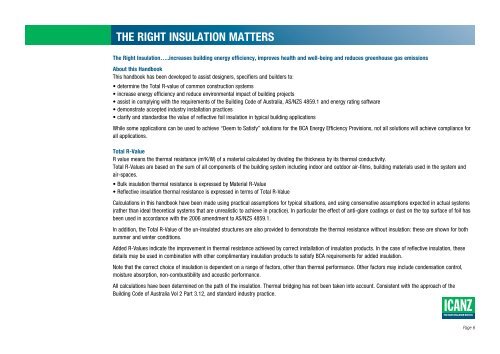INSULATION HANDBOOK Part 1: Thermal Performance - icanz
INSULATION HANDBOOK Part 1: Thermal Performance - icanz
INSULATION HANDBOOK Part 1: Thermal Performance - icanz
Create successful ePaper yourself
Turn your PDF publications into a flip-book with our unique Google optimized e-Paper software.
THE RIGHT <strong>INSULATION</strong> MATTERS<br />
The Right Insulation…..increases building energy efficiency, improves health and well-being and reduces greenhouse gas emissions<br />
About this Handbook<br />
This handbook has been developed to assist designers, specifiers and builders to:<br />
• determine the Total R-value of common construction systems<br />
• increase energy efficiency and reduce environmental impact of building projects<br />
• assist in complying with the requirements of the Building Code of Australia, AS/NZS 4859.1 and energy rating software<br />
• demonstrate accepted industry installation practices<br />
• clarify and standardise the value of reflective foil insulation in typical building applications<br />
While some applications can be used to achieve “Deem to Satisfy” solutions for the BCA Energy Efficiency Provisions, not all solutions will achieve compliance for<br />
all applications.<br />
Total R-Value<br />
R value means the thermal resistance (m2K/W) of a material calculated by dividing the thickness by its thermal conductivity.<br />
Total R-Values are based on the sum of all components of the building system including indoor and outdoor air-films, building materials used in the system and<br />
air-spaces.<br />
• Bulk insulation thermal resistance is expressed by Material R-Value<br />
• Reflective insulation thermal resistance is expressed in terms of Total R-Value<br />
Calculations in this handbook have been made using practical assumptions for typical situations, and using conservative assumptions expected in actual systems<br />
(rather than ideal theoretical systems that are unrealistic to achieve in practice). In particular the effect of anti-glare coatings or dust on the top surface of foil has<br />
been used in accordance with the 2006 amendment to AS/NZS 4859.1.<br />
In addition, the Total R-Value of the un-insulated structures are also provided to demonstrate the thermal resistance without insulation: these are shown for both<br />
summer and winter conditions.<br />
Added R-Values indicate the improvement in thermal resistance achieved by correct installation of insulation products. In the case of reflective insulation, these<br />
details may be used in combination with other complimentary insulation products to satisfy BCA requirements for added insulation.<br />
Note that the correct choice of insulation is dependent on a range of factors, other than thermal performance. Other factors may include condensation control,<br />
moisture absorption, non-combustibility and acoustic performance.<br />
All calculations have been determined on the path of the insulation. <strong>Thermal</strong> bridging has not been taken into account. Consistent with the approach of the<br />
Building Code of Australia Vol 2 <strong>Part</strong> 3.12, and standard industry practice.<br />
Page 6


